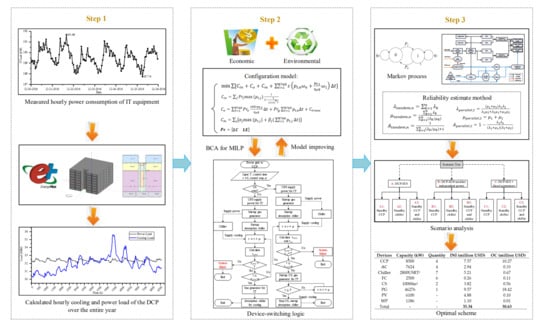Configuration Optimization Model for Data-Center-Park-Integrated Energy Systems under Economic, Reliability, and Environmental Considerations
Abstract
1. Introduction
1.1. DCP-IESs and Their Key Characteristics
1.2. Literature Review
1.3. Scientific Contribution of the Study
2. Existing Problems to Solve
2.1. Three Coupled Configuration Issues
2.2. Redundancy and Device Switching Problems
3. Methodology
3.1. Hypotheses
3.2. Configuration Model
3.3. Equipment Model Based on Operational Data
3.4. Estimation of System Reliability
4. Case Study
4.1. Cooling and Power Load Prediction Using Operational Data
4.2. Basic Parameter Determination
4.3. Results
4.4. Switching Logic Analysis
4.5. Reliability Analysis and Redundant Design
5. Conclusions
- In the multi-objective configuration model, the carbon emissions of DCP-IESs were converted into economic indicators through carbon pricing and were optimized for the initial investment, operational costs, and maintenance costs of the system. Renewable energy, waste heat, free-cooling, and cooling storage were all considered. Compared with traditional energy systems, the results indicated that it would only take 2.88 years for the economics of the DCP-IES to catch up to those of the TDC-ES; the carbon emissions of the DCP-IES were 39,323 tons lower than those for the TDC-ES, and the PUE was 1.389.
- Multi-energy integration led to the frequent device switching of the DCP-IES. Based on the given device switching logic, the relevant constraints for avoiding the switching faults were fed back into the configuration model to correct the model. The results indicated that the total initial investment increased by $0.24 million, and the PUE was 1.388.
- In 12 scenarios of redundant design, both the cooling availability and power availability of DCP-IESs were calculated for systems with parallel- and series-arranged devices, based on Markov processes. The results indicated that the total initial investment for the DCP-IES meeting the four “9” reliability requirement, represented by Scenario A3, was $37.41 million, and the total initial investment for the DCP-IES meeting the five “9” reliability requirement, represented by Scenario B2, was $45.21 million. As the reliability increases, the initial investment cost increases increasingly faster.
- Using the new energy configuration method, the configuration scheme of the DCP-IES could be obtained under economical, low-carbon, and reliability requirements. With the help of the new DCP-IES configuration model, DCP planners can easily obtain energy indicators during the planning stage, designers can quickly achieve low-carbon energy allocations, and operators can obtain operational strategies of system devices based on real-time load forecasting results.
Author Contributions
Funding
Conflicts of Interest
Nomenclature
| Acronyms | |
| DCP-IES | data-center-park-integrated energy system |
| DCP | data center park |
| ECT | energy conversion technology |
| FC | free-cooling |
| UPS | uninterrupted power supplies |
| IDC | internet data center |
| PUE | power usage effectiveness |
| ACS | air conditioning system |
| TDC-ES | traditional data center energy system |
| CHP | combined heating and power |
| CCP | combined cooling and power |
| MILP | mixed integer linear programming |
| SSP | stationary state probability |
| INI | initial investment |
| OC | operating cost |
| CE | carbon emissions |
| AC | absorption chiller |
| CS | cooling storage |
| PG | power grid |
| PV | photovoltaic |
| WP | wind power |
| USD | United States Dollar ($) |
| Indices | |
| the output of each energy conversion technology at every hour (kW) | |
| the uniform annual value of initial cost ($) | |
| the annual operative cost ($) | |
| the equipment maintenance cost ($) | |
| the carbon trading price ($/tCO2) | |
| the carbon emission factor of natural gas (tCO2/Nm3) | |
| the carbon emission factor of power grid (tCO2/kWh) | |
| the discount rate | |
| the generating efficiency of CCP | |
| the time interval (h) | |
| the lower calorific value of natural gas (kJ/Nm3) | |
| the price per unit capacity of device j ($/kW) | |
| the service life of technology j (year) | |
| the time-of-use electricity price ($/kWh) | |
| the natural gas price ($/Nm3) | |
| basic power cost of transformer ($) | |
| the fixed cost factor of device j ($/kW) | |
| the variable cost factor of equipment j ($/kWh) | |
| the coefficient matrix | |
| the column vector of cooling loads | |
| the column vector of electrical loads | |
| the state of equipment j | |
| the efficiency of equipment j for producing cooling or heating | |
| the minimum output of equipment j (kW) | |
| the rated capacity of equipment j (kW) | |
| the partial load ratio | |
| the column vector of system electrical loads excluding consumption by chillers | |
| the maximum of free-cooling capacity that can be carried in the environment at t (kW) | |
| the wet-bulb temperature outdoors (K) | |
| the gross cooling storage at time t (kWh) | |
| failure rate (time/day) | |
| repair rate (time/day) | |
| transfer density matrix | |
| the SSP vector of each state | |
| the number of states | |
| the availability rate of the system with n devices connected in series (%) | |
| the investment payback period (year) | |
| the selling price of electricity ($/kWh) | |
| the selling price of cooling ($/kWh) | |
| The pre-cooling time of AC (min) | |
| the available capacity of cooling storage (kWh) | |
| the available capacity of UPS (kWh) | |
Appendix A
References
- China National Information Infrastructure. The Research Report of Chinese IDC Market Trend and Investment Strategy in 2017–2019; China National Information Infrastructure: Beijing, China, 2016. [Google Scholar]
- Song, X.; Liu, L.; Zhu, T.; Zhang, T.; Wu, Z. Comparative analysis on operation strategies of CCHP system with cool thermal storage for a data center. Appl. Therm. Eng. 2016, 108, 680–688. [Google Scholar] [CrossRef]
- Huang, P.; Copertaro, B.; Zhang, X.; Shen, J.; Löfgren, I.; Rönnelid, M.; Fahlen, J.; Andersson, D.; Svanfeldt, M. A review of data centers as prosumers in district energy systems: Renewable energy integration and waste heat reuse for district heating. Appl. Energy 2020, 258, 114109. [Google Scholar] [CrossRef]
- Rong, H.; Zhang, H.; Xiao, S.; Li, C.; Hu, C. Optimizing energy consumption for data centers. Renew. Sustain. Energy Rev. 2016, 58, 674–691. [Google Scholar] [CrossRef]
- Ding, T.; He, Z.G.; Hao, T.; Li, Z. Application of separated heat pipe system in data center cooling. Appl. Therm. Eng. 2016, 109, 207–216. [Google Scholar] [CrossRef]
- Jaureguialzo, E. PUE: The Green Grid metric for evaluating the energy efficiency in DC (Data Center). Measurement method using the power demand. In Proceedings of the 2011 IEEE 33rd International Telecommunications Energy Conference (INTELEC), Amsterdam, The Netherlands, 9–13 October 2011; pp. 1–8. [Google Scholar]
- Sharma, M.; Arunachalam, K.; Sharma, D. Analyzing the data center efficiency by using PUE to make data centers more energy efficient by reducing the electrical consumption and exploring new strategies. Procedia Comput. Sci. 2015, 48, 142–148. [Google Scholar] [CrossRef]
- International Energy Agency. Global Energy & CO2 Status Report; International Energy Agency: Paris, France, 2018. [Google Scholar]
- Sevencan, S.; Lindbergh, G.; Lagergren, C.; Alvfors, P. Economic feasibility study of a fuel cell-based combined cooling, heating and power system for a data centre. Energy Build. 2016, 111, 218–223. [Google Scholar] [CrossRef]
- Rossi, F.D.; Xavier, M.G.; De Rose, C.A.F.; Calheiros, R.N.; Buyya, R. E-eco: Performance-aware energy-efficient cloud data center orchestration. J. Netw. Comput. Appl. 2017, 78, 83–96. [Google Scholar] [CrossRef]
- Asghari, N.; Mandjes, M.; Walid, A. Energy-efficient scheduling in multi-core servers. Comput. Netw. 2014, 59, 33–43. [Google Scholar] [CrossRef]
- Li, X.; Qian, Z.; Lu, S.; Wu, J. Energy efficient virtual machine placement algorithm with balanced and improved resource utilization in a data center. Math. Comput. Model. 2013, 58, 22–35. [Google Scholar] [CrossRef]
- Wang, Y.; Wang, X. Performance-controlled server consolidation for virtualized data centers with multi-tier applications. Sustain. Comput. Inform. Syst. 2014, 4, 52–65. [Google Scholar] [CrossRef]
- Chen, H.; Zhu, X.; Guo, H.; Qin, X.; Zhu, J.; Wu, J. Towards energy-efficient scheduling for real-time tasks under uncertain cloud computing environment. J. Syst. Softw. 2014, 53, 50–58. [Google Scholar] [CrossRef]
- Cho, K.; Chang, H.; Jung, Y.; Yoon, Y. Economic analysis of data center cooling strategies. Sustain. Cities Soc. 2017, 31, 234–243. [Google Scholar] [CrossRef]
- Ni, J.; Bai, X. A review of air conditioning energy performance in data centers. Renew. Sustain. Energy Rev. 2017, 67, 625–640. [Google Scholar] [CrossRef]
- Lu, H.; Zhang, Z.; Yang, L. A review on airflow distribution and management in data center. Energy Build. 2018, 179, 264–277. [Google Scholar] [CrossRef]
- Ham, S.-W.; Kim, M.-H.; Choi, B.-N.; Jeong, J.-W. Energy saving potential of various air-side economizers in a modular data center. Appl. Energy 2015, 138, 258–275. [Google Scholar] [CrossRef]
- Yu, J.; Jiang, Y.; Yan, Y. A simulation study on heat recovery of data center: A case study in Harbin, China. Renew. Energy 2019, 130, 154–173. [Google Scholar] [CrossRef]
- Oró, E.; Depoorter, V.; Garcia, A.; Salom, J. Energy efficiency and renewable energy integration in data centres. Strategies and modelling review. Renew. Sustain. Energy Rev. 2015, 42, 429–445. [Google Scholar] [CrossRef]
- Tian, H.; He, Z.; Li, Z. A combined cooling solution for high heat density data centers using multi-stage heat pipe loops. Energy Build. 2015, 94, 177–188. [Google Scholar] [CrossRef]
- Yue, C.; Zhang, Q.; Zhai, Z.; Ling, L. Numerical investigation on thermal characteristics and flow distribution of a parallel micro-channel separate heat pipe in data center. Int. J. Refrig. 2019, 98, 150–160. [Google Scholar] [CrossRef]
- Zhou, F.; Wei, C.; Ma, G. Development and analysis of a pump-driven loop heat pipe unit for cooling a small data center. Appl. Therm. Eng. 2017, 124, 1169–1175. [Google Scholar] [CrossRef]
- Dong, K.; Li, P.; Huang, Z.; Su, L.; Sun, Q. Research on free cooling of data centers by using indirect cooling of open cooling tower. Procedia Eng. 2017, 205, 2831–2838. [Google Scholar] [CrossRef]
- Yang, Y.; Wang, B.; Zhou, Q. Air conditioning system design using free cooling technology and running mode of a data center in Jinan. Procedia Eng. 2017, 205, 3545–3549. [Google Scholar] [CrossRef]
- Zhang, H.; Shao, S.; Xu, H.; Zou, H.; Tian, C. Free cooling of data centers: A review. Renew. Sustain. Energy Rev. 2014, 35, 171–182. [Google Scholar] [CrossRef]
- Sheme, E.; Holmbacka, S.; Lafond, S.; Lučanin, D.; Frashëri, N. Feasibility of using renewable energy to supply data centers in 60° north latitude. Sustain. Comput. Inform. Syst. 2018, 17, 96–106. [Google Scholar] [CrossRef]
- Wang, Y.; Wang, X.; Yu, H.; Huang, Y.; Dong, H.; Qi, C.; Baptiste, N. Optimal design of integrated energy system considering economics, autonomy and carbon emissions. J. Clean. Prod. 2019, 225, 563–578. [Google Scholar] [CrossRef]
- Tran, H.N.; Narikiyo, T.; Kawanishi, M.; Kikuchi, S.; Takaba, S. Whole-day optimal operation of multiple combined heat and power systems by alternating direction method of multipliers and consensus theory. Energy Convers. Manag. 2018, 174, 475–488. [Google Scholar] [CrossRef]
- Van der, H.; Vandermeulen, A.; Salenbien, H. Integrated optimal design and control of fourth generation district heating networks with thermal energy storage. Energies 2019, 12, 2766. [Google Scholar] [CrossRef]
- Reynolds, J.; Ahmad, M.W.; Rezgui, Y.; Hippolyte, J.-L. Operational supply and demand optimisation of a multi-vector district energy system using artificial neural networks and a genetic algorithm. Appl. Energy 2019, 235, 699–713. [Google Scholar] [CrossRef]
- Ritchie, A.J.; Brouwer, J. Design of fuel cell powered data centers for sufficient reliability and availability. J. Power Sources 2018, 384, 196–206. [Google Scholar] [CrossRef]
- Wang, J.; Zhang, Q.; Yoon, S.; Yu, Y. Reliability and availability analysis of a hybrid cooling system with water-side economizer in data center. Build. Environ. 2019, 148, 405–416. [Google Scholar] [CrossRef]
- Figueirêdo, J.; Maciel, P.; Callou, G.; Tavares, E.; Sousa, E.; Silva, B. Estimating reliability importance and total cost of acquisition for data center power infrastructures. In Proceedings of the 2011 IEEE International Conference on Systems, Man, and Cybernetics, Anchorage, AK, USA, 9–12 October 2011; pp. 421–426. [Google Scholar]
- Ma, H.; Li, C.; Lu, W.; Zhang, Z.; Yu, S.; Du, N. Experimental study of a multi-energy complementary heating system based on a solar-groundwater heat pump unit. Appl. Therm. Eng. 2016, 109, 718–726. [Google Scholar] [CrossRef]
- Gillespie, D.T. (Ed.) 1-RANDOM VARIABLE THEORY. In Markov Processes; Academic Press: San Diego, CA, USA, 1992; pp. 1–58. [Google Scholar]
- Cranston, M.; Greven, A. Coupling and harmonic functions in the case of continuous time Markov processes. Process. Their Appl. 1995, 60, 261–286. [Google Scholar] [CrossRef][Green Version]
- Wang, J. Optimal Design of Building Cooling Heating and Power System and Its Multi-Criteria Integrated Evaluation Method; North China Electric Power University: Beijing, China, 2012. [Google Scholar]
- Crawley, D.B.; Lawrie, L.K.; Winkelmann, F.C.; Buhl, W.F.; Huang, Y.J.; Pedersen, C.O.; Strand Richard, K.; Liesen Richard, J.; Fisher Daniel, E.; Witte Michael, J.; et al. EnergyPlus: Creating a new-generation building energy simulation program. Energy Build. 2001, 33, 319–331. [Google Scholar] [CrossRef]
- Fumo, N.; Mago, P.; Luck, R. Methodology to estimate building energy consumption using Energy Plus Benchmark Models. Energy Build. 2010, 42, 2331–2337. [Google Scholar] [CrossRef]
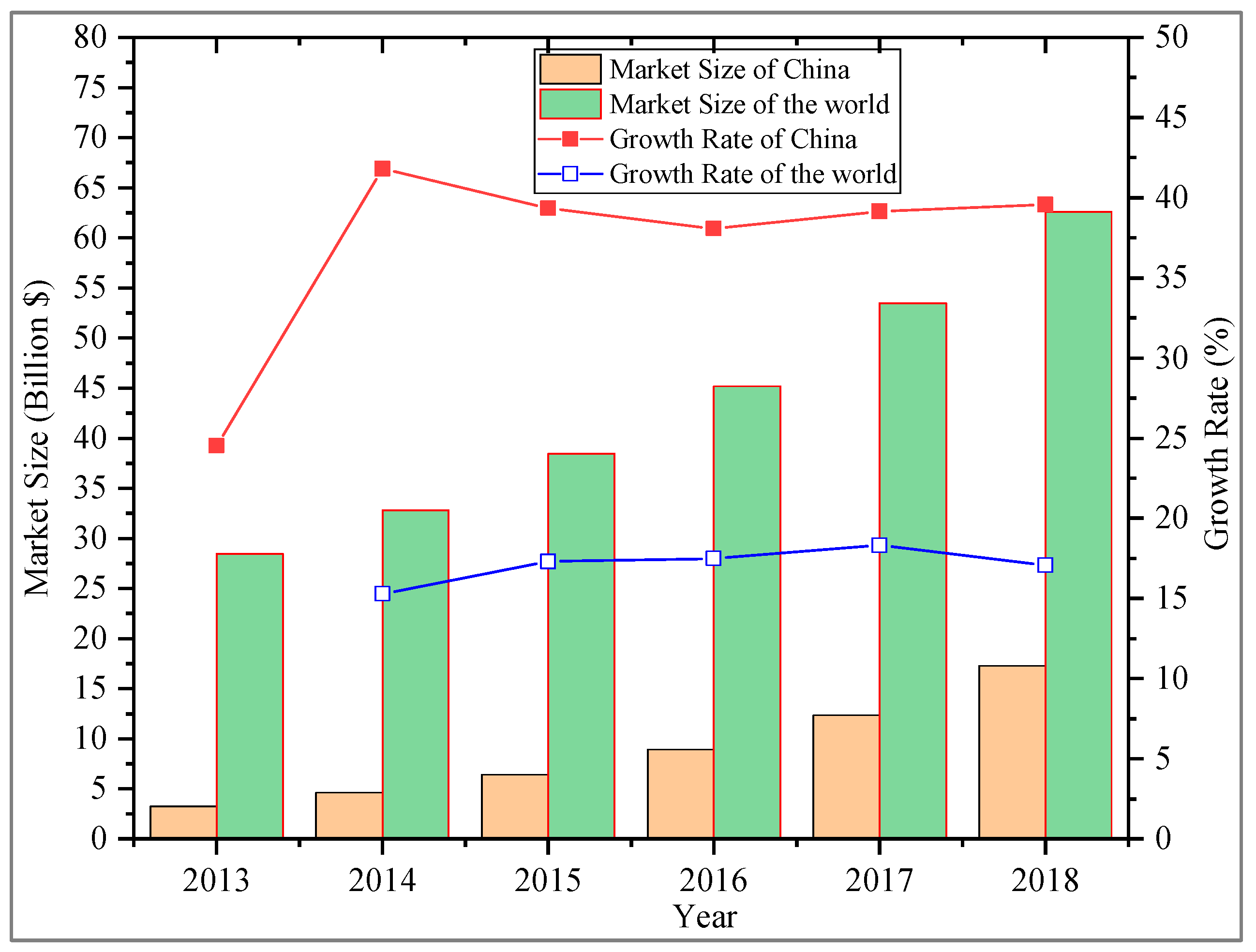
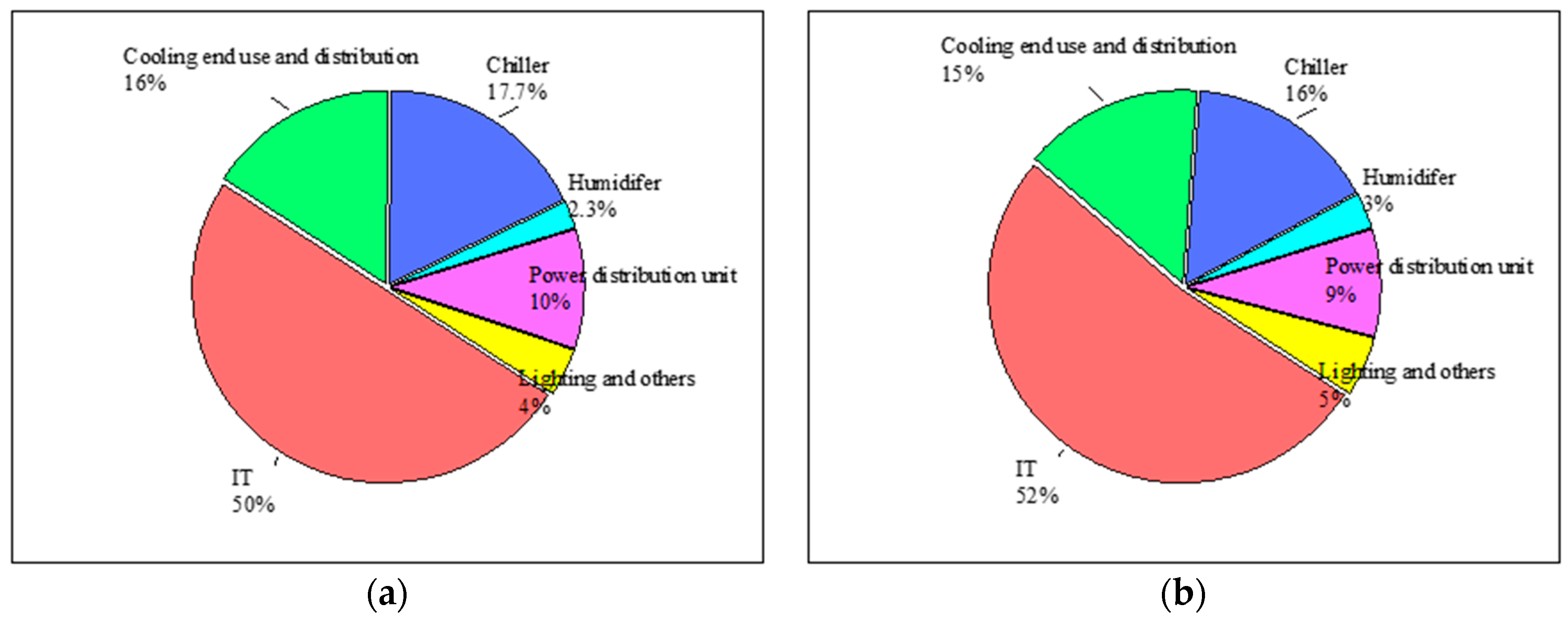
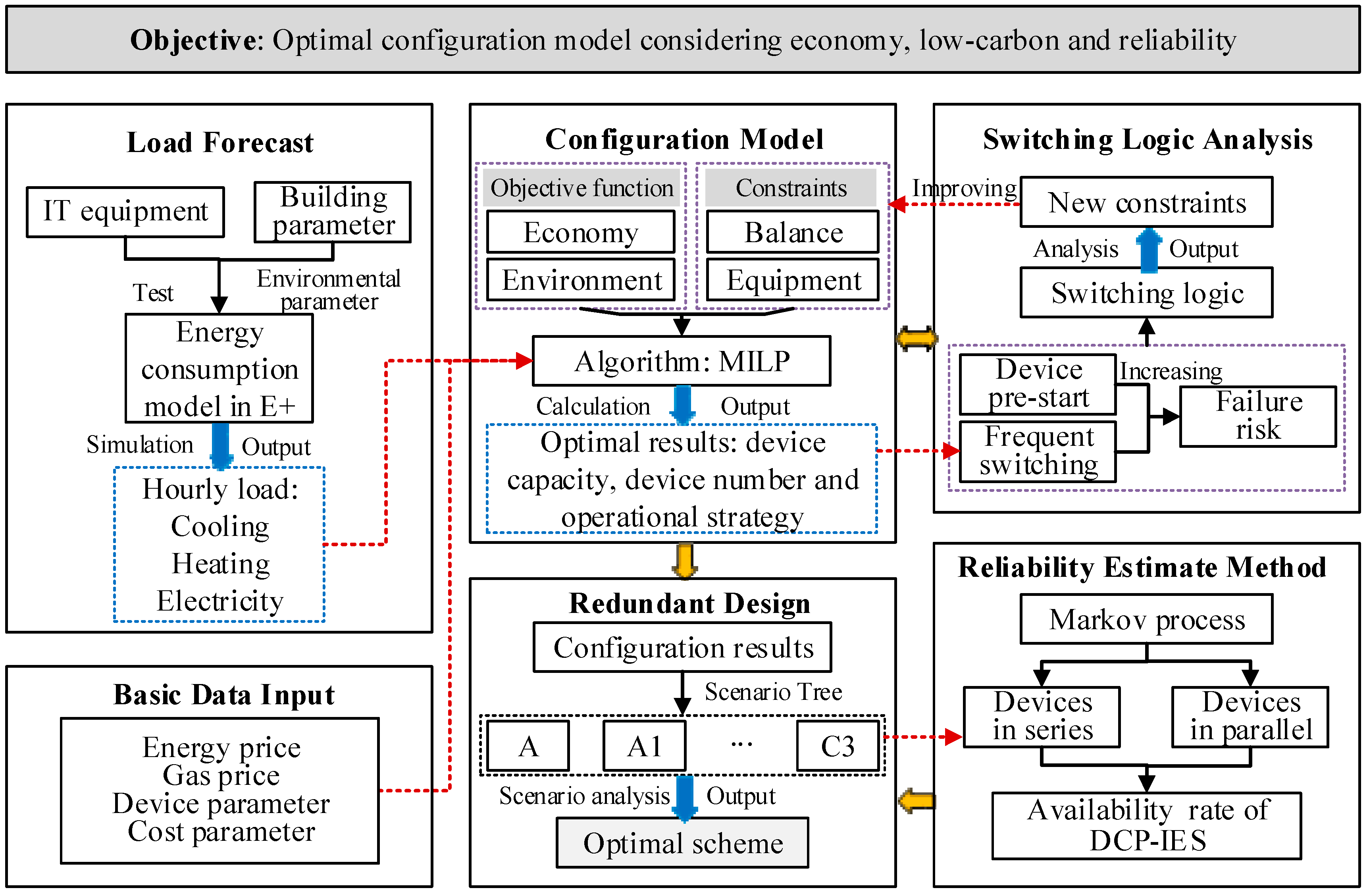
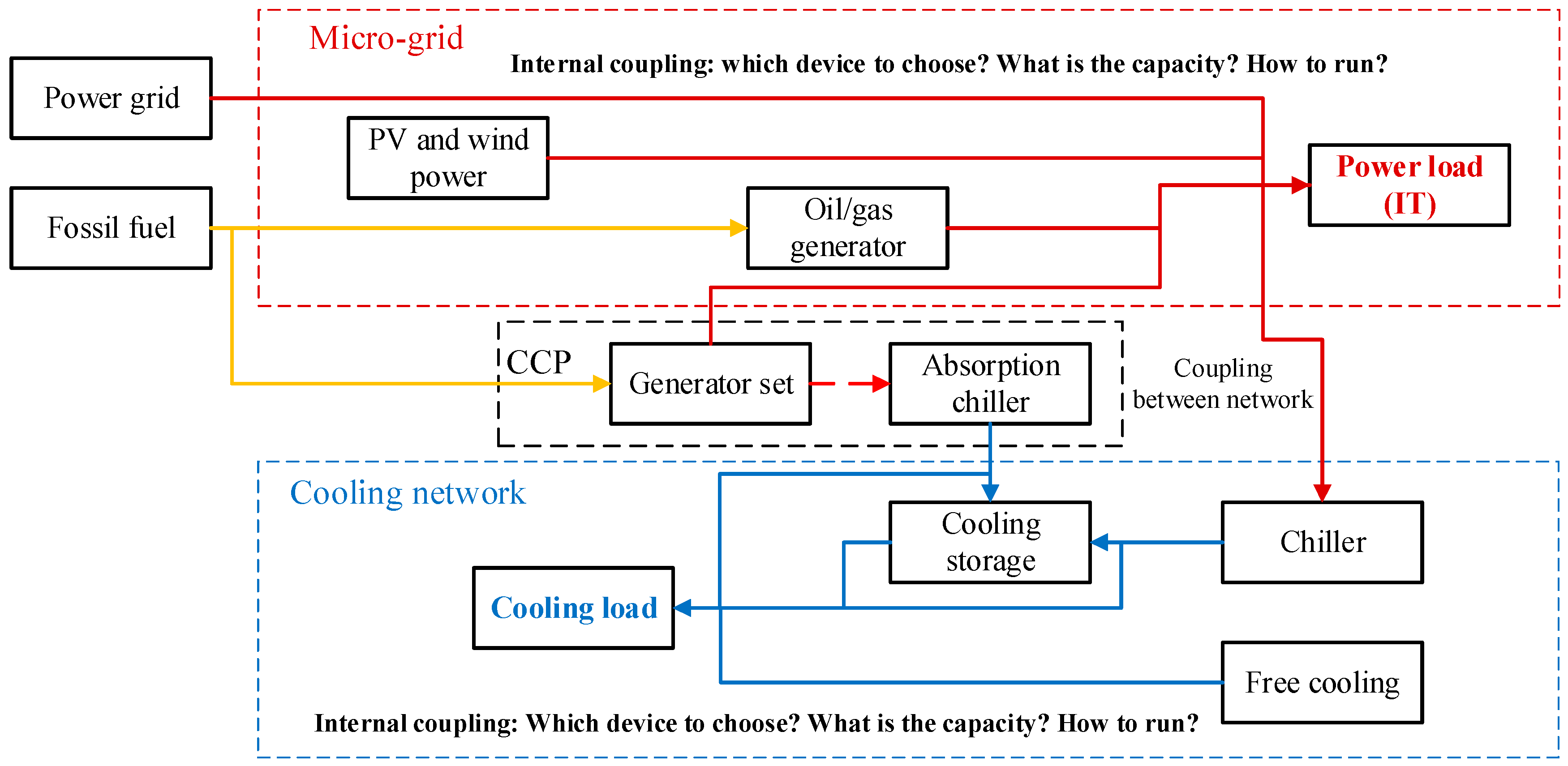
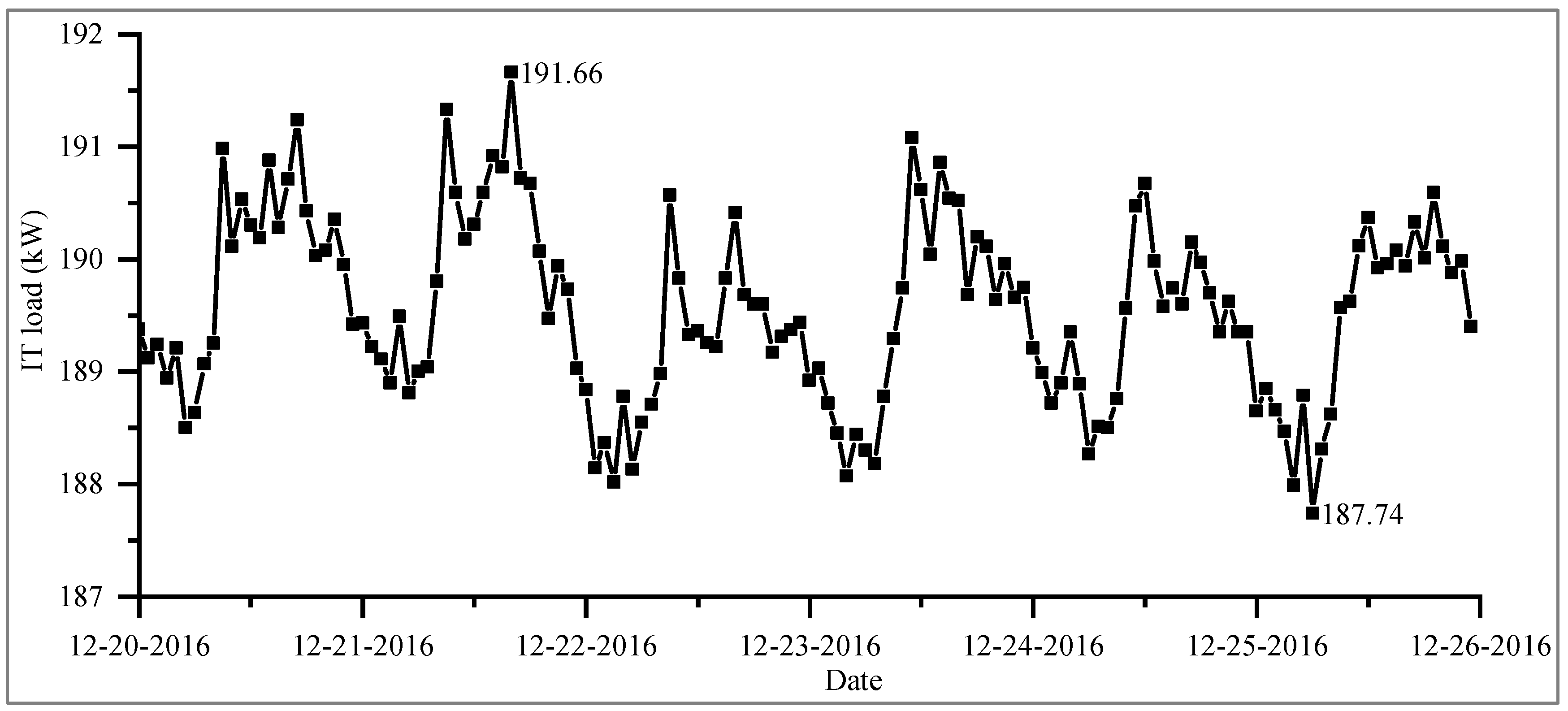
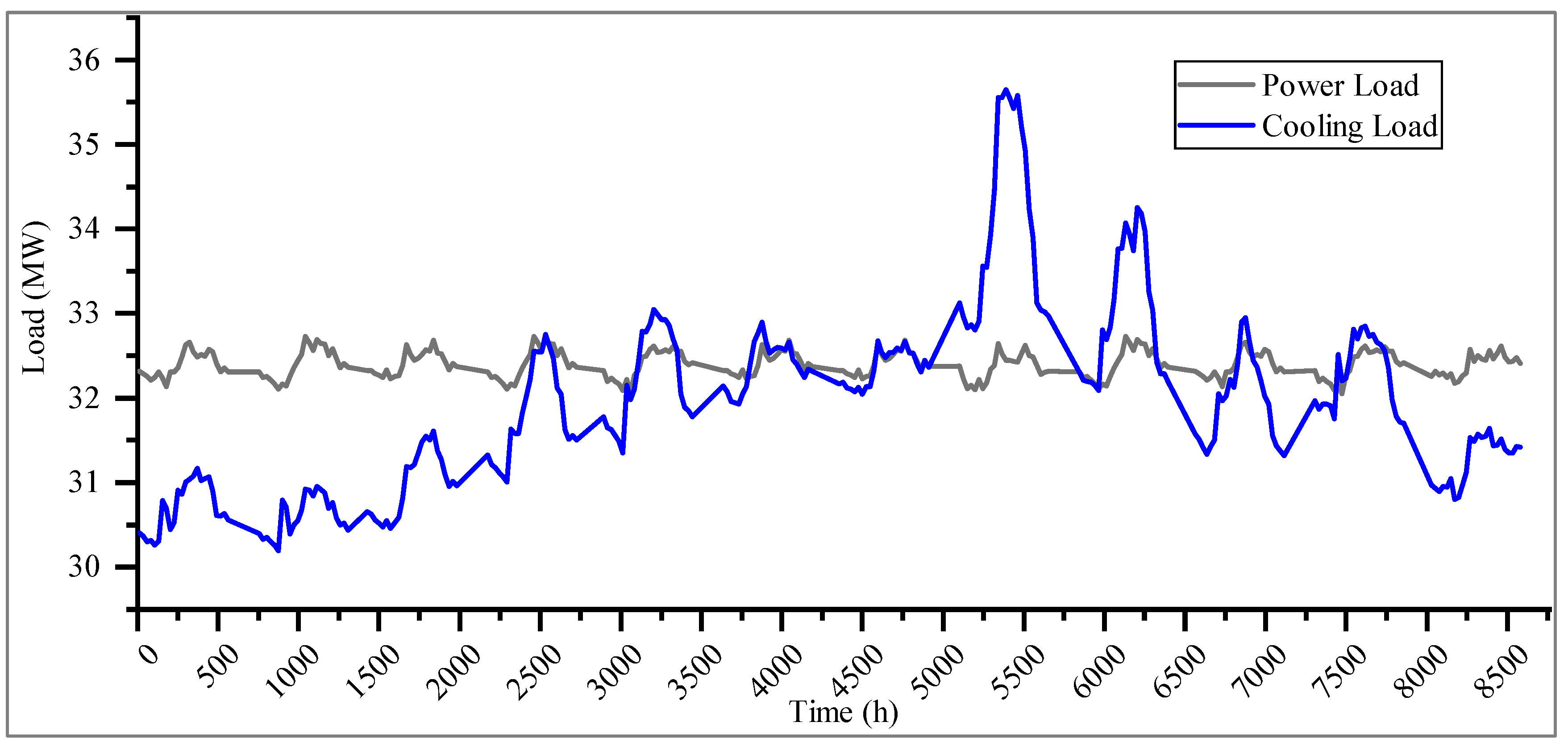
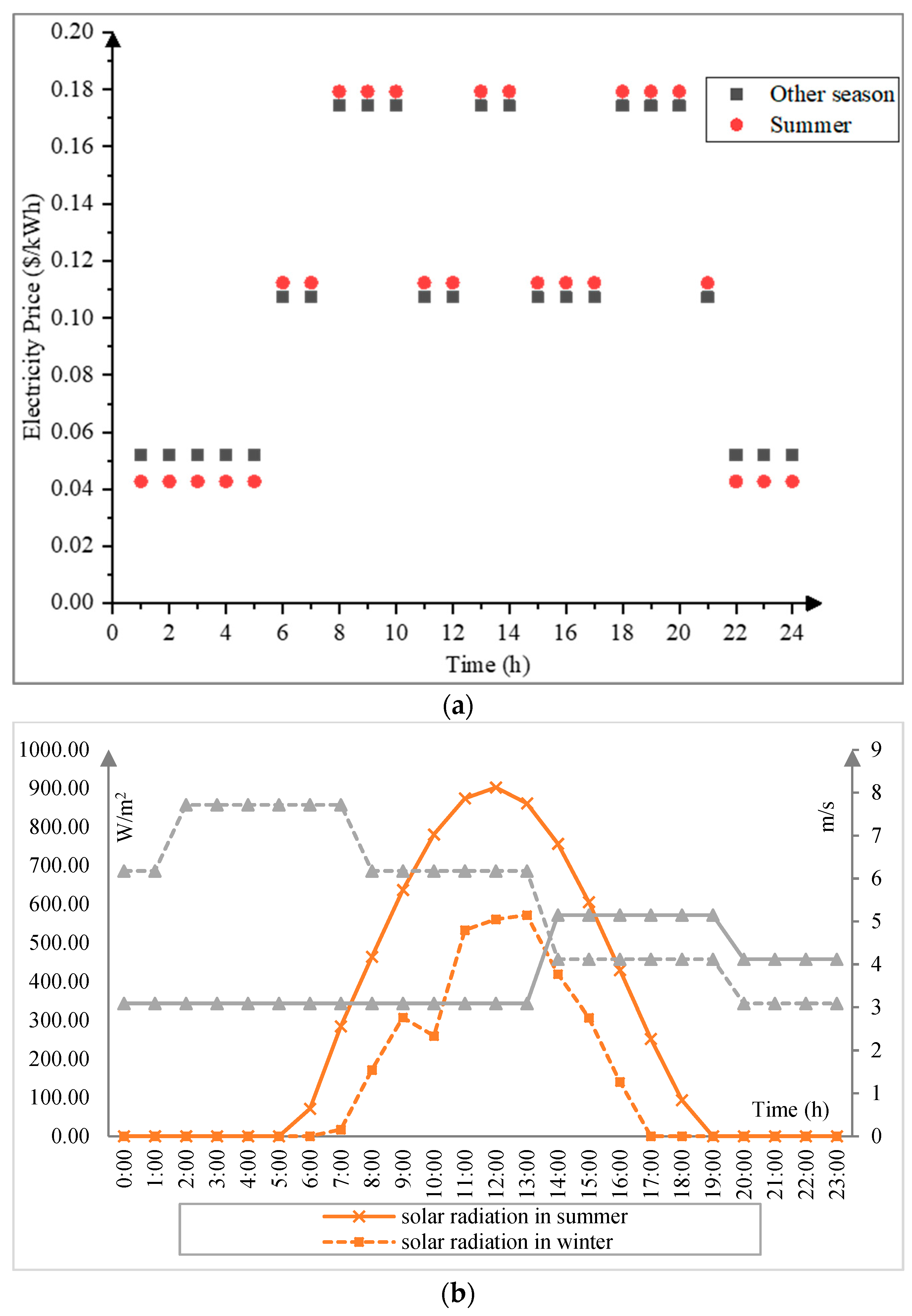
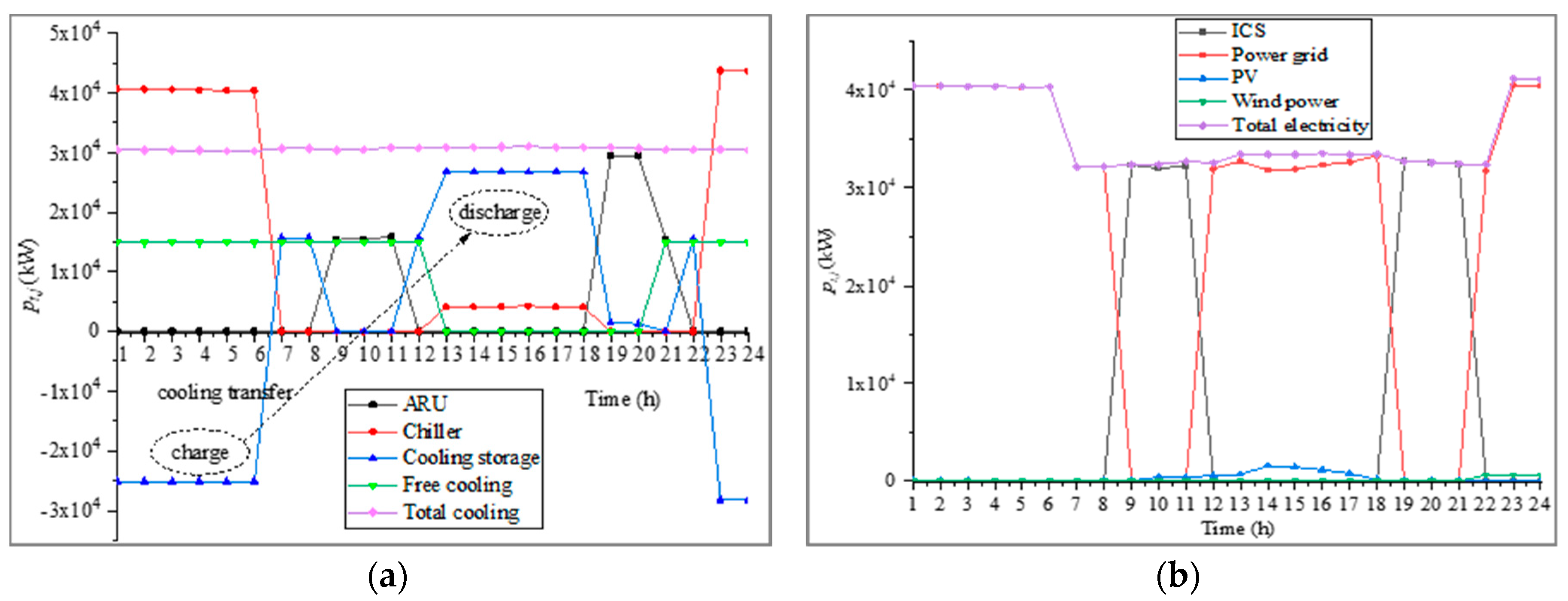
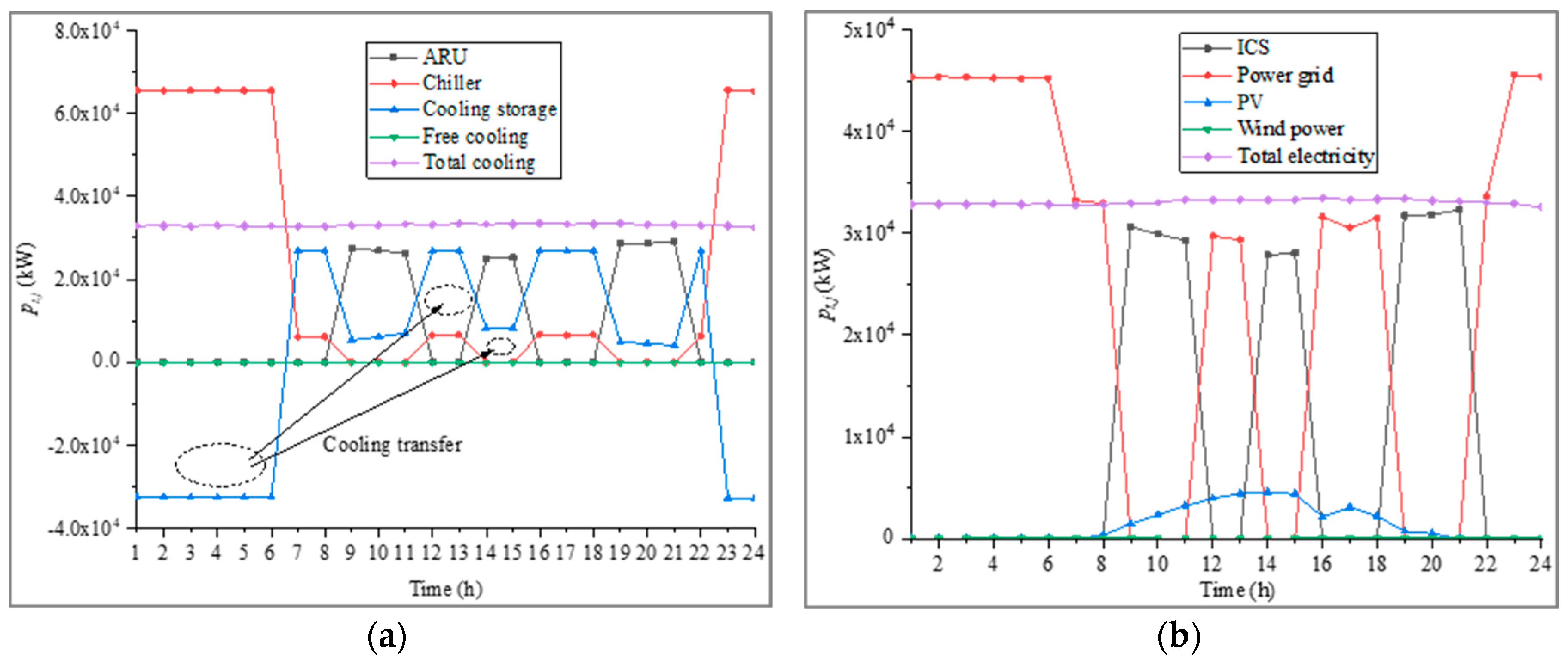
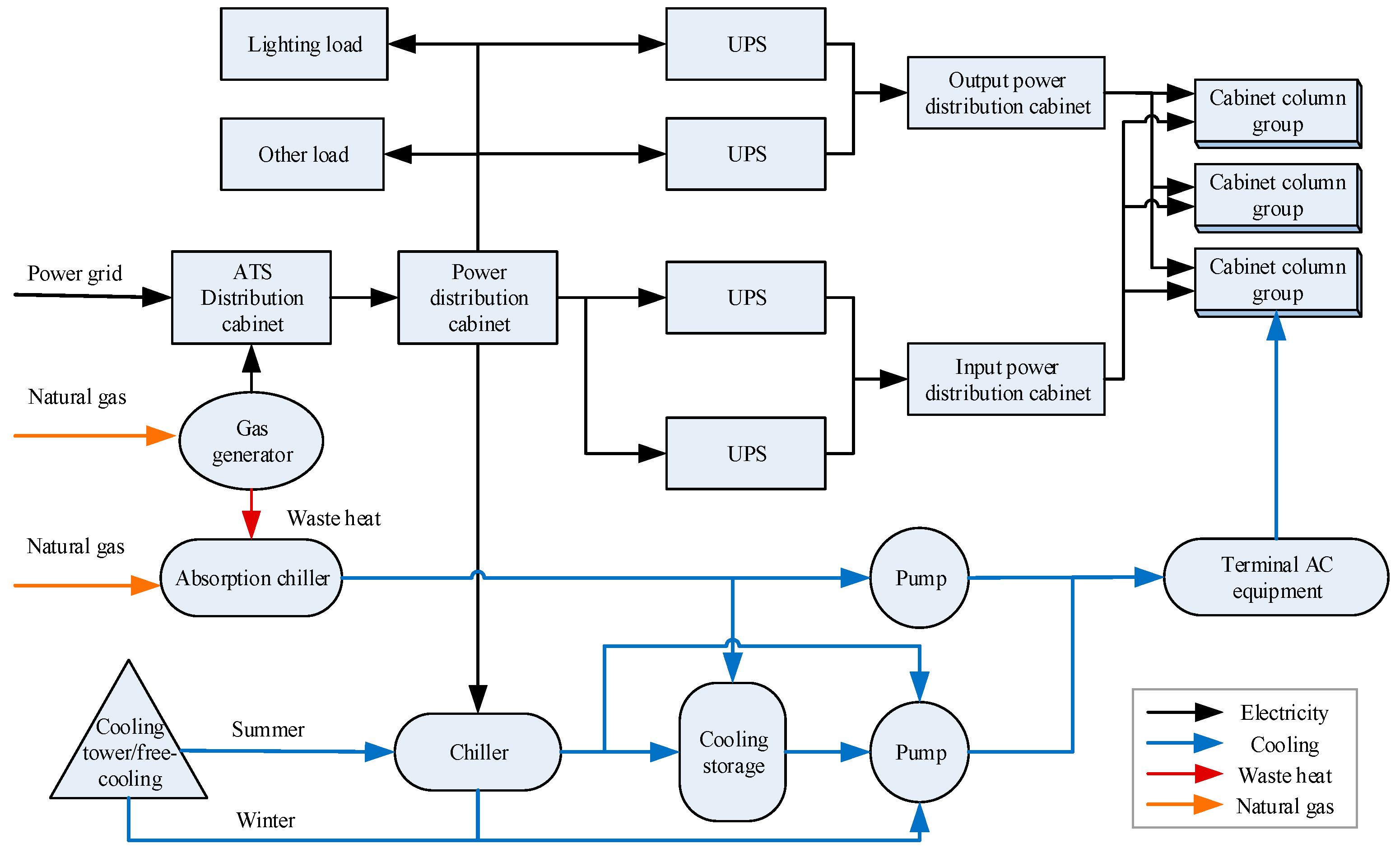
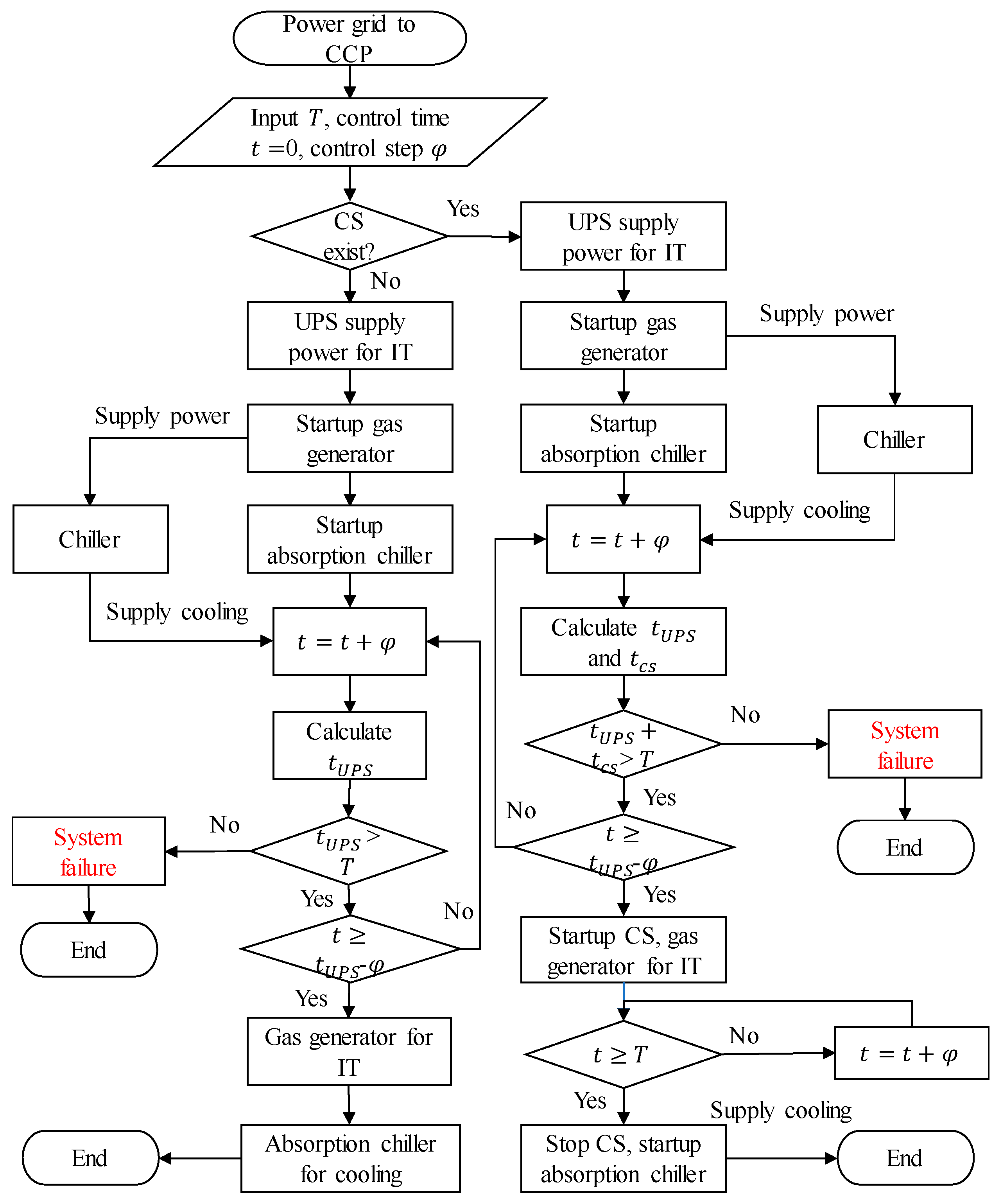
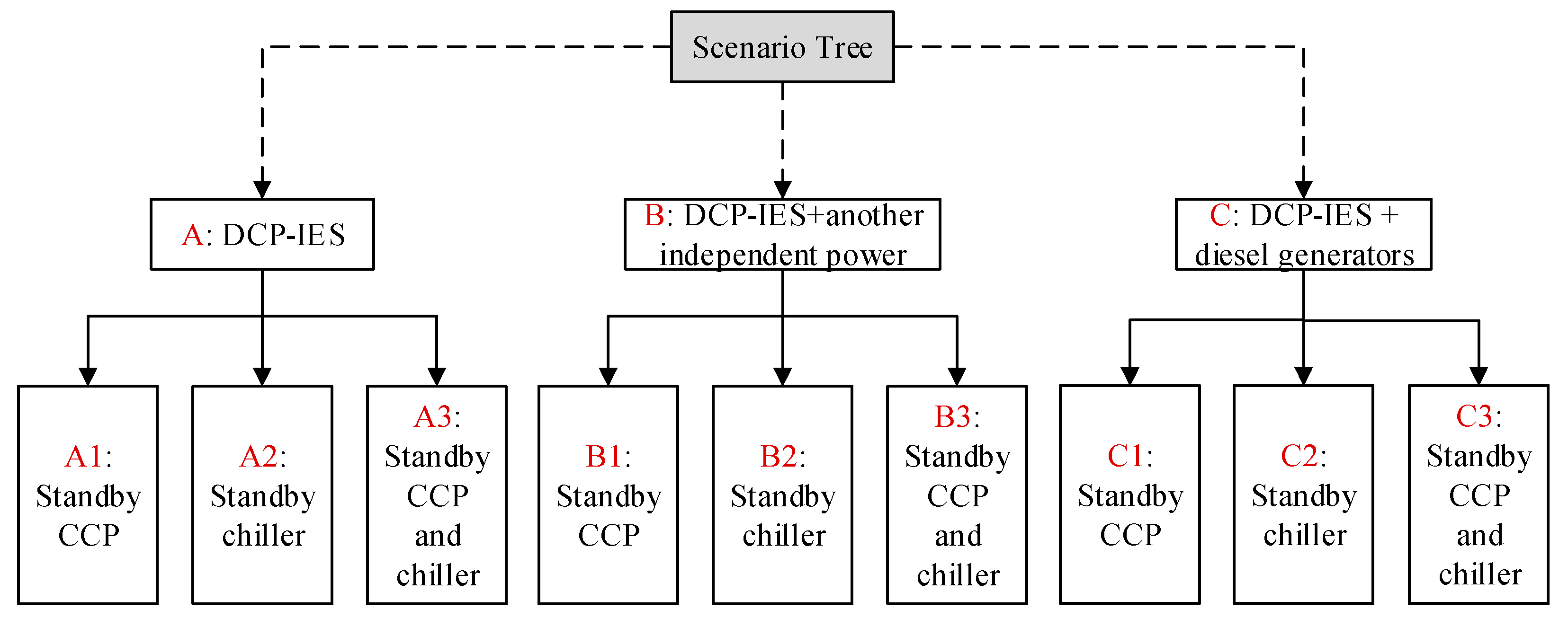
| Electric Power Industry | Carbon Emission Factor (tCO2/MWh) |
|---|---|
| China (2017) | 0.620 |
| USA (2017) | 0.420 |
| UK (2017) | 0.237 |
| Germany (2016) | 0.560 |
| France (2017) | 0.074 |
| Japan (2016) | 0.544 |
| Russia (2016) | 0.358 |
| India (2017) | 0.723 |
| 1 | 2 | 3 | 4 | 5 | 6 | 7 | 8 | |
|---|---|---|---|---|---|---|---|---|
| Energy conversion technology | CCP | Absorption chiller | Chiller | Free-cooling | Cooling storage | Power grid | PV | Wind power |
| Device J | COP | ||||||
|---|---|---|---|---|---|---|---|
| 1 | 225.03 | 1.93 | 0.014 | 20 | 0.46 | 40 | - |
| 2 | 99.82 | 1.77 | 0.004 | 15 | - | - | 0.9 |
| 3 | 74.72 | 1.77 | 0.003 | 20 | - | - | 5.8 |
| 4 | 16.83 | 1.40 | 0.003 | 20 | - | - | - |
| 5 | 114.08 $/m3 | 1.57 | 0.003 | 20 | - | - | - |
| 6 | 14.26 | 0.00 | 0.003 | 20 | - | - | - |
| 7 | 798.59 | 2.07 | 0.013 | 25 | - | - | - |
| 8 | 926.93 | 2.07 | 0.013 | 20 | - | - | - |
| Iterations | 1 | 20 | 40 | 60 | 80 | 100 | 120 | 140 | |
|---|---|---|---|---|---|---|---|---|---|
| Computing time (s) | BCA | 1803 | 1743 | 1821 | 1845 | 1794 | 1827 | 1819 | 1807 |
| NSGA-II | 150 | 167 | 334 | 497 | 733 | 1972 | 2145 | 3156 | |
| INI 1 (million USD) | BCA | 35.09 | 35.09 | 35.09 | 35.09 | 35.09 | 35.09 | 35.09 | 35.09 |
| NSGA-II | 37.69 | 36.69 | 35.86 | 36.36 | 35.19 | 35.69 | 35.36 | 35.16 | |
| OC 2 (million USD) | BCA | 30.45 | 30.45 | 30.45 | 30.45 | 30.45 | 30.45 | 30.45 | 30.45 |
| NSGA-II | 32.17 | 31.99 | 32.06 | 31.09 | 30.74 | 31.16 | 31.31 | 30.81 | |
| CE 3 (tCO2) | BCA | 232,250 | 232,250 | 232,250 | 232,250 | 232,250 | 232,250 | 232,250 | 232,250 |
| NSGA-II | 245,335 | 243,972 | 244,517 | 237,157 | 234,431 | 237,702 | 238,792 | 234,976 | |
| Types | CCP | AC 1 | Chiller | FC 2 | CS 3 | PG 4 | PV | WP 5 | Total |
|---|---|---|---|---|---|---|---|---|---|
| DCP-IES INI (million USD) | 7.37 | 2.94 | 5.18 | 0.26 | 3.81 | 9.57 | 4.88 | 1.10 | 35.09 |
| DCP-IES OC (million USD) | 10.27 | 0.33 | 0.64 | 0.11 | 0.56 | 18.42 | 0.10 | 0.01 | 30.45 |
| DCP-IES CE (tCO2) | 42,488 | 0 | 0 | 0 | 0 | 189,762 | 0 | 0 | 232,250 |
| TDC-ES INI (million USD) | 0 | 0 | 2.99 | 0 | 0 | 8.71 | 0 | 0 | 11.71 |
| TDC-ES OC (million USD) | 0 | 0 | 0.86 | 0 | 0 | 37.69 | 0 | 0 | 38.55 |
| TDC-ES CE (tCO2) | 0 | 0 | 0 | 0 | 0 | 271,573 | 0 | 0 | 271,573 |
| Devices | Capacity (kW) | Quantity | INI (Million USD) | OC (Million USD) |
|---|---|---|---|---|
| CCP | 8500 | 4 | 7.57 | 10.27 |
| AC | 7624 | 4 | 2.94 | 0.33 |
| Chiller | 2800USRT 1 | 7 | 5.21 | 0.67 |
| FC | 2500 | 6 | 0.26 | 0.11 |
| CS | 10,000 m3 | 2 | 3.82 | 0.56 |
| PG | 46,276 | 1 | 9.57 | 18.42 |
| PV | 6100 | - | 4.88 | 0.10 |
| WP | 1186 | - | 1.10 | 0.01 |
| Total | - | - | 35.34 | 30.63 |
| Device | CCP | AC | Chiller | FC | CS | PG | PV | WP |
|---|---|---|---|---|---|---|---|---|
| Failure rate (time/day) | 0.00547945 | 0.00136986 | 0.000913240 | 0.000684790 | 0.0103903 | 0.00305800 | 0.0170452 | 0.0121137 |
| Repair rate (time/day) | 2.541667 | 2.000000 | 2.000000 | 1.000000 | 1.000000 | 5.083333 | 3.2906082 | 3.4042571 |
| Redundant Scenario | Available Rate of Electricity (%) | Available Rate of Cooling (%) | INI (Million USD) |
|---|---|---|---|
| A | 99.9399 | 99.9894 | 35.34 |
| A1 | 99.9900 | 99.9897 | 37.11 |
| A2 | 99.9399 | 99.9940 | 35.64 |
| A3 | 99.9900 | 99.9948 | 37.41 |
| B | 99.9996 | 99.9954 | 44.91 |
| B1 | 99.9998 | 99.9957 | 46.67 |
| B2 | 99.9996 | 99.9992 | 45.21 |
| B3 | 99.9998 | 99.9993 | 46.97 |
| C | 99.9989 | 99.9935 | 43.44 |
| C1 | 99.9995 | 99.9935 | 45.21 |
| C2 | 99.9989 | 99.9989 | 43.74 |
| C3 | 99.9995 | 99.9990 | 45.51 |
© 2020 by the authors. Licensee MDPI, Basel, Switzerland. This article is an open access article distributed under the terms and conditions of the Creative Commons Attribution (CC BY) license (http://creativecommons.org/licenses/by/4.0/).
Share and Cite
Liu, Z.; Yu, H.; Liu, R.; Wang, M.; Li, C. Configuration Optimization Model for Data-Center-Park-Integrated Energy Systems under Economic, Reliability, and Environmental Considerations. Energies 2020, 13, 448. https://doi.org/10.3390/en13020448
Liu Z, Yu H, Liu R, Wang M, Li C. Configuration Optimization Model for Data-Center-Park-Integrated Energy Systems under Economic, Reliability, and Environmental Considerations. Energies. 2020; 13(2):448. https://doi.org/10.3390/en13020448
Chicago/Turabian StyleLiu, Zhiyuan, Hang Yu, Rui Liu, Meng Wang, and Chaoen Li. 2020. "Configuration Optimization Model for Data-Center-Park-Integrated Energy Systems under Economic, Reliability, and Environmental Considerations" Energies 13, no. 2: 448. https://doi.org/10.3390/en13020448
APA StyleLiu, Z., Yu, H., Liu, R., Wang, M., & Li, C. (2020). Configuration Optimization Model for Data-Center-Park-Integrated Energy Systems under Economic, Reliability, and Environmental Considerations. Energies, 13(2), 448. https://doi.org/10.3390/en13020448




